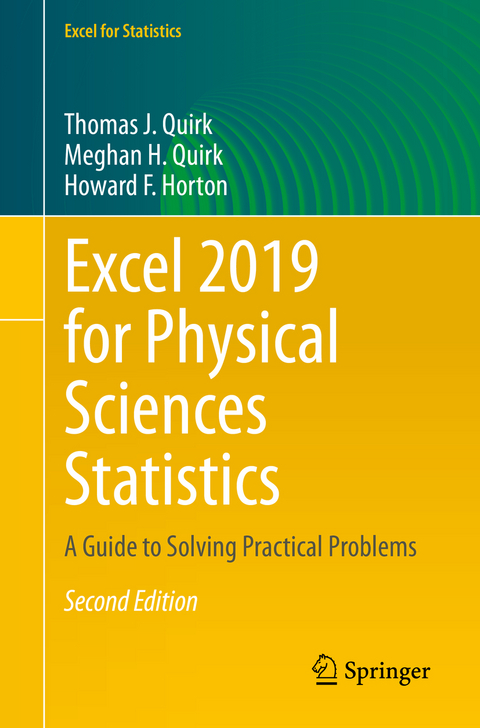
Excel 2019 for Physical Sciences Statistics
Springer International Publishing (Verlag)
978-3-030-63237-3 (ISBN)
This book shows the capabilities of Microsoft Excel in teaching physical science statistics effectively. Similar to the previously published Excel 2016 for Physical Sciences Statistics, this book is a step-by-step, exercise-driven guide for students and practitioners who need to master Excel to solve practical physical science problems. If understanding statistics isn't the reader's strongest suit, the reader is not mathematically inclined, or if the reader is new to computers or to Excel, this is the book to start off with.
Excel, a widely available computer program for students and managers, is also an effective teaching and learning tool for quantitative analyses in physical science courses. Its powerful computational ability and graphical functions make learning statistics much easier than in years past. Excel 2019 for Physical Sciences Statistics: A Guide to Solving Practical Problems capitalizes on these improvements by teaching students and managers how to apply Excel to statistical techniques necessary in their courses and work.
In this new edition, each chapter explains statistical formulas and directs the reader to use Excel commands to solve specific, easy-to-understand physical science problems. Practice problems are provided at the end of each chapter with their solutions in an appendix. Separately, there is a full practice test (with answers in an appendix) that allows readers to test what they have learned.
lt;p>
Prof. Tom J. Quirk is a Professor Emeritus of Marketing in The Walker School of Business & Technology at Webster University in St. Louis, Missouri (US). He has published over 20 articles in professional journals, and presented more than 20 papers at professional conferences. He holds a BS in Mathematics from John Carroll University, both an MA in Education and a PhD in Educational Psychology from Stanford University, and an MBA from The University of Missouri-St. Louis.
Dr. Meghan H. Quirk holds a PhD in Biological Education and an MA in Biological Sciences from the University of Northern Colorado (UNC) and a BA in Biology and Religion at Principia College in Elsah, Illinois. She has done research on foodweb dynamics at Wind Cave National Park in South Dakota and research in agro-ecology in Southern Belize. She has co-authored an article on shortgrass steppe ecosystems in Photochemistry & Photobiology. She was a National Science Foundation Fellow GK-12, and currently is a public school administrator in Parker, Colorado.
Howard F. Horton holds an MS in Biological Sciences from the University of Northern Colorado (UNC) and a BS in Biological Sciences from Mesa State College. He has worked on research projects in Pawnee National Grasslands, Rocky Mountain National Park, Long-Term Ecological Research at Toolik Lake, Alaska, and Wind Cave, South Dakota. He has co-authored articles in The International Journal of Speleology and The Journal of Cave and Karst Studies. He was a National Science Foundation Fellow GK-12 and a District Wildlife manager with the Colorado Division of Parks and Wildlife. He is currently the Angler Outreach Coordinator with the Colorado Division of Parks and Wildlife.
Preface.- Acknowledgements.- 1 Sample Size, Mean, Standard Deviation, and Standard Error of the Mean.- 2 Random Number Generator.- 3 Confidence Interval About the Mean Using the TINV Function and Hypothesis Testing.- 4 One-Group t-Test for the Mean.- 5 Two-Group t-Test of the Difference of the Means for Independent Groups.- 6 Correlation and Simple Linear Regression.- 7 Multiple Correlation and Multiple Regression.- 8 One-Way Analysis of Variance (ANOVA).- Appendix A: Answers to End-of-Chapter Practice Problems.- Appendix B: Practice Test.- Appendix C: Answers to Practice Test.- Appendix D: Statistical Formulas.- Appendix E: t-table.- Index.
"Successive chapters deal with elementary notions in statistics and the corresponding Excel calculations ... . Exercises are provided at the end of each chapter, and the volume ends with solutions, some numerical tables, and an index. A stated in its title, the volume aims at solving 'practical problems' as encountered in a wide diversity of domains by professionals or undergraduate students, for whom it is recommended." (L. -F. Pau, Computing Reviews, October 31, 2022)
“Successive chapters deal with elementary notions in statistics and the corresponding Excel calculations … . Exercises are provided at the end of each chapter, and the volume ends with solutions, some numerical tables, and an index. A stated in its title, the volume aims at solving ‘practical problems’ as encountered in a wide diversity of domains by professionals or undergraduate students, for whom it is recommended.” (L. -F. Pau, Computing Reviews, October 31, 2022)
| Erscheinungsdatum | 08.04.2021 |
|---|---|
| Reihe/Serie | Excel for Statistics |
| Zusatzinfo | XIX, 242 p. 166 illus., 161 illus. in color. |
| Verlagsort | Cham |
| Sprache | englisch |
| Maße | 155 x 235 mm |
| Gewicht | 409 g |
| Themenwelt | Mathematik / Informatik ► Mathematik ► Angewandte Mathematik |
| Mathematik / Informatik ► Mathematik ► Statistik | |
| Mathematik / Informatik ► Mathematik ► Wahrscheinlichkeit / Kombinatorik | |
| Naturwissenschaften ► Physik / Astronomie | |
| Sozialwissenschaften | |
| Schlagworte | Applied Physical Science Statistics • Excel 2019 • Excel 2019 Physical Sciences Statistics • Excel 2019 Textbook • Excel for Physical Science • Excel Guide • Excel Statistics • Natural Sciences Statistics • Practical Physical Science Statistics • Statistical Physics • Statistics for Physical Science |
| ISBN-10 | 3-030-63237-7 / 3030632377 |
| ISBN-13 | 978-3-030-63237-3 / 9783030632373 |
| Zustand | Neuware |
| Haben Sie eine Frage zum Produkt? |
aus dem Bereich


